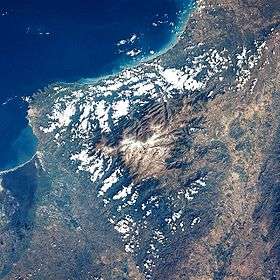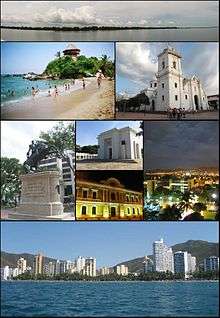Santa Marta
| Santa Marta | |||
|---|---|---|---|
| City | |||
|
Top:Panorama view of the Cienaga Grande de Santa Marta, from inside the swamp, 2nd left:View of Mirador in Cabo San Juan del Guia, Tayrona Natural Park, 2nd right:Santa Marta Cathedral (La Casa del Farol), 3rd left:Statue of Simon Bolivar in Quinta of Saint Pedro Alejandrino, 3rd upper middle:Colombian National Pantheon in Barrio Mamatoco, 3rd lower middle:Night view of Snta Marta City Hall, 3rd right:Twilight view of Tribute to the Tayrona Ethnicity Square, Bottom:Panoramic view of Acuatico El Rodadero Park and resort area, from De Gaira area | |||
| |||
| Nickname(s): America's Pearl (La Perla de America) | |||
 Location in the Department of Magdalena. Municipality (dark grey) City (red) | |||
 Santa Marta Location in Colombia | |||
| Coordinates: 11°14′31″N 74°12′19″W / 11.24194°N 74.20528°WCoordinates: 11°14′31″N 74°12′19″W / 11.24194°N 74.20528°W | |||
| Country |
| ||
| Region | Caribbean Region | ||
| Department | Magdalena | ||
| Foundation | July 29, 1525 | ||
| Founded by | Rodrigo de Bastidas | ||
| Named for | Martha | ||
| Government | |||
| • Mayor | Rafael Martínez (2016-2019) (Liberal) | ||
| Area | |||
| • City | 2,393.65 km2 (924.07 sq mi) | ||
| • Urban | 55.10 km2 (21.27 sq mi) | ||
| Elevation | 6 m (20 ft) | ||
| Highest elevation | 5,775 m (18,947 ft) | ||
| Population (2010)[1] | |||
| • City | 454,860 | ||
| • Density | 190/km2 (490/sq mi) | ||
| • Urban | 385,122 | ||
| • Urban density | 6,989.5/km2 (18,106.3/sq mi) | ||
| DANE | |||
| Demonym(s) | Samario | ||
| Time zone | Colombia Standard Time (UTC-05) | ||
| Area code(s) | 57 + 5 | ||
| Website | Official website (Spanish) | ||
Santa Marta, officially Distrito Turístico, Cultural e Histórico de Santa Marta ("Touristic, Cultural and Historic District of Santa Marta"), is a city in Colombia. It is the capital of the department of Magdalena and fourth largest urban city of the Caribbean Region of Colombia, after Barranquilla, Cartagena, and Soledad. Founded on July 29, 1525, by the Spanish conquistador Rodrigo de Bastidas, it was the first Spanish settlement in Colombia, and is the oldest surviving city in that country, and second oldest in South America.[2] This city is situated on a bay of the same name and as such, is a prime tourist destination.[3]
History
Pre-Columbian times
Before the arrival of Europeans, the South American continent was inhabited by a number of indigenous groups. Due to a combination of tropical weather, significant rainfall, and the destruction and misrepresentation of many records by Spanish conquistadors, our understanding of the peoples of this region is limited.
The Tairona formed mid- to large-size population centers, consisting of stone pathways, terraces, protected waterways, and spaces dedicated to agricultural produce. Their economy was primarily agricultural, cultivating corn, pineapple, yucca, and other local foodstuffs. The Tayrona are considered quite advanced for their time period. Surviving archaeological sites consisted of formed terraces and small scale underground stone channels. They also were known to actively collect and process salt, which was a significant trading commodity. We know that they traded with other indigenous groups along the coast and interior. Archaeological excavations have recovered significant works in pottery, stonework and gold.
Flag
Santa Marta’s flag consists of two colours: white and blue. White symbolises peace, in that all are united without restriction. Blue symbolises the sky, the sea, the magic found in the horizon, and the snow-capped Sierra Nevada mountains.
Geography

Santa Marta is located on Santa Marta Bay of the Caribbean Sea in the province of Magdalena. It is 992 km from Bogotá and 93 km from Barranquilla. It is bordered to the north and west by the Caribbean and to the south by the municipalities of Aracataca and Ciénaga.
Economy
Santa Marta's economy is based on tourism, trade, port activities, fishing and agriculture, in that order. The main agricultural products are: bananas, coffee, cocoa and cassava.
Infrastructure
Santa Marta is a major port. Simon Bolivar International Airport (IATA: SMR ) is 16 km (10 mi) from the city centre. It should be noted that historic figure Simon Bolivar died here, a significant event for South America as a whole. His villa known as La Quinta de San Pedro Alejandrino is located just outside the city centre. As the main city centre is located close to the coast, the city itself has had difficulty controlling expansion. Although, technically a separate locality, Rodadero is often considered part of Santa Marta itself.
- Quinta de San Pedro Alejandrino in Santa Marta
- Monument of Rodrigo Bastidas

- Lighthouse in the bay Santa Marta
 Rodadero, Santa Marta.
Rodadero, Santa Marta.- Sunset from Irotama Resort
- Port of Santa Marta.
Twin towns
Santa Marta has one sister city: Miami Beach, Florida.[4]
Climate
| Climate data for Santa Marta (Simón Bolívar International Airport) 1981–2010 | |||||||||||||
|---|---|---|---|---|---|---|---|---|---|---|---|---|---|
| Month | Jan | Feb | Mar | Apr | May | Jun | Jul | Aug | Sep | Oct | Nov | Dec | Year |
| Record high °C (°F) | 37.0 (98.6) |
38.2 (100.8) |
37.0 (98.6) |
37.6 (99.7) |
37.4 (99.3) |
37.4 (99.3) |
37.8 (100) |
37.4 (99.3) |
37.2 (99) |
36.2 (97.2) |
38.2 (100.8) |
37.6 (99.7) |
38.2 (100.8) |
| Average high °C (°F) | 33.0 (91.4) |
33.6 (92.5) |
33.8 (92.8) |
33.6 (92.5) |
32.9 (91.2) |
33.0 (91.4) |
33.0 (91.4) |
32.8 (91) |
32.5 (90.5) |
32.1 (89.8) |
32.1 (89.8) |
32.4 (90.3) |
32.9 (91.2) |
| Daily mean °C (°F) | 27.4 (81.3) |
27.9 (82.2) |
28.4 (83.1) |
28.9 (84) |
29.1 (84.4) |
29.1 (84.4) |
28.8 (83.8) |
28.6 (83.5) |
28.3 (82.9) |
27.9 (82.2) |
27.8 (82) |
27.5 (81.5) |
28.3 (82.9) |
| Average low °C (°F) | 22.3 (72.1) |
23.2 (73.8) |
24.2 (75.6) |
25.3 (77.5) |
25.5 (77.9) |
25.1 (77.2) |
24.6 (76.3) |
24.5 (76.1) |
24.3 (75.7) |
24.2 (75.6) |
23.8 (74.8) |
22.7 (72.9) |
24.1 (75.4) |
| Record low °C (°F) | 17.4 (63.3) |
18.3 (64.9) |
20.0 (68) |
19.0 (66.2) |
18.0 (64.4) |
19.0 (66.2) |
18.0 (64.4) |
18.0 (64.4) |
17.0 (62.6) |
17.0 (62.6) |
17.0 (62.6) |
18.0 (64.4) |
17.0 (62.6) |
| Average rainfall mm (inches) | 3.1 (0.122) |
2.0 (0.079) |
2.3 (0.091) |
14.1 (0.555) |
55.4 (2.181) |
60.7 (2.39) |
59.6 (2.346) |
70.0 (2.756) |
88.3 (3.476) |
111.0 (4.37) |
63.5 (2.5) |
15.2 (0.598) |
545.3 (21.469) |
| Average rainy days | 0 | 1 | 1 | 3 | 7 | 9 | 10 | 13 | 13 | 13 | 8 | 2 | 80 |
| Average relative humidity (%) | 74 | 72 | 72 | 74 | 76 | 76 | 77 | 78 | 79 | 80 | 79 | 76 | 76 |
| Mean monthly sunshine hours | 285.2 | 248.6 | 251.1 | 228.0 | 223.2 | 228.0 | 232.5 | 220.1 | 201.0 | 204.6 | 219.0 | 269.7 | 2,811 |
| Mean daily sunshine hours | 9.2 | 8.8 | 8.1 | 7.6 | 7.2 | 7.6 | 7.5 | 7.1 | 6.7 | 6.6 | 7.3 | 8.7 | 7.7 |
| Source: Instituto de Hidrologia Meteorologia y Estudios Ambientales[5][6][7] | |||||||||||||
See also
References
- ↑ "Boletín Censo General 2005 - Perfil Santa Marta" (PDF). DANE. Retrieved 27 Nov 2012.
- ↑ "Santa Marta historia y tradición" (in Spanish). Ministerio de Educación Nacional. Retrieved 2009. Check date values in:
|access-date=(help) - ↑ "Colombia" (in Spanish). Decameron. Retrieved 28 May 2009.
- ↑ Miami Beach Sister Cities Program
- ↑ "Promedios Climatológicos 1981–2010" (in Spanish). Instituto de Hidrologia Meteorologia y Estudios Ambientales. Archived from the original on 14 August 2016. Retrieved 16 August 2016.
- ↑ "Promedios Climatológicos 1971–2000" (in Spanish). Instituto de Hidrologia Meteorologia y Estudios Ambientales. Archived from the original on 14 August 2016. Retrieved 16 August 2016.
- ↑ "Tiempo y Clima" (in Spanish). Instituto de Hidrologia Meteorologia y Estudios Ambientales. Archived from the original on 14 August 2016. Retrieved 16 August 2016.
External links
- (Spanish) Santa Marta at analitica.com
- (Spanish) UNIMAGDALENA
- (Spanish) Bank of the Republic, economic history of Santa Marta
External links
-
 Media related to Santa Marta at Wikimedia Commons
Media related to Santa Marta at Wikimedia Commons -
 Santa Marta travel guide from Wikivoyage
Santa Marta travel guide from Wikivoyage -
 "Santa Marta". New International Encyclopedia. 1905.
"Santa Marta". New International Encyclopedia. 1905.


.svg.png)